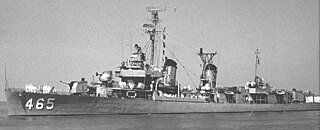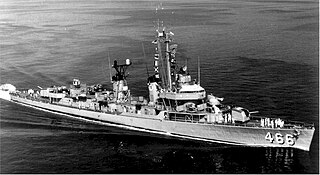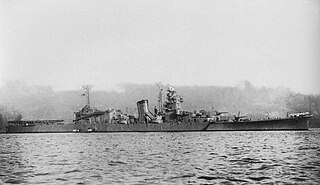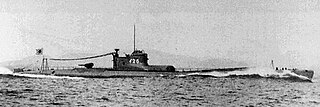The escort carrier or escort aircraft carrier, also called a "jeep carrier" or "baby flattop" in the United States Navy (USN) or "Woolworth Carrier" by the Royal Navy, was a small and slower type of aircraft carrier used by the Royal Navy, the Royal Canadian Navy, the United States Navy, the Imperial Japanese Navy and Imperial Japanese Army Air Force in World War II. They were typically half the length and a third the displacement of larger fleet carriers, more-lightly armed and armored, and carried fewer planes. Escort carriers were most often built upon a commercial ship hull, so they were cheaper and could be built quickly. This was their principal advantage as they could be completed in greater numbers as a stop-gap when fleet carriers were scarce. However, the lack of protection made escort carriers particularly vulnerable, and several were sunk with great loss of life. The light carrier was a similar concept to the escort carrier in most respects, but was fast enough to operate alongside fleet carriers.

USS Hornet (CV-8), the seventh U.S. Navy vessel of that name, was a Yorktown-class aircraft carrier of the United States Navy.

Nachi (那智) was the second vessel completed of the four-member Myōkō class of heavy cruisers of the Imperial Japanese Navy (IJN), which were active in World War II. The other ships of the class were Myōkō, Ashigara, and Haguro. She was named after a mountain in Wakayama Prefecture.

USS Liscome Bay (ACV/CVE-56) was the second of fifty Casablanca-class escort carriers built to serve the United States Navy during World War II. Launched in April 1943 and commissioned the following August, she was named for Liscome Bay in Dall Island in the Alexander Archipelago of Alaska. On 24 November 1943, her munitions were catastrophically detonated by a torpedo attack by the Japanese submarine I-175 while she was acting as the flagship of Carrier Division 24, which was supporting operations on Makin. She quickly sank with the loss of 702 officers and sailors. Her loss is the deadliest sinking of a carrier in the history of the United States Navy.

USS Hollandia (CVE-97) was a Casablanca-class escort carrier of the United States Navy. She was named after the Battle of Hollandia, a successful amphibious operation during the New Guinea campaign. Launched in April 1944, and commissioned in June, she served in support of the Battle of Okinawa. Postwar, she participated in Operation Magic Carpet. She was decommissioned in January 1947, when she was mothballed in the Pacific Reserve Fleet. Ultimately, she was sold for scrap in December 1960.

USS Salamaua (CVE-96) was a Casablanca-class escort carrier of the United States Navy. She was named after the invasion of Salamaua, a strategically important village in the New Guinea Theater during World War II, and one of the main targets of the Salamaua–Lae campaign. She served with distinction during the war, notably being damaged in early 1945 by a kamikaze aircraft during the Invasion of Lingayen Gulf, killing 15 crewmen and injuring 88. Post war, the ship helped repatriate servicemen to the United States as part of Operation Magic Carpet before being decommissioned and struck in 1946, and ultimately being broken up in 1947.

USS Hoggatt Bay (CVE-75) was the twenty-first of fifty Casablanca-class escort carriers built for the United States Navy during World War II. She was named after Hoggatt Bay, which was named in 1895 by Lieutenant commander E. K. Moore after Wilford Bacon Hoggatt, an ensign serving in Moore's party at the time. The bay is located within Baranof Island, part of the Alexander Archipelago, which at the time was a part of the Territory of Alaska. She was launched in December 1943, commissioned in January 1944, and she served in the Mariana and Palau Islands campaign, the Invasion of Lingayen Gulf as a part of the Philippines campaign, as well as the Battle of Okinawa. Post-war, she participated in Operation Magic Carpet, repatriating U.S. servicemen from around the Pacific. She was decommissioned in July 1946, being mothballed in the Atlantic Reserve Fleet. Ultimately, she was broken up in 1960.

The Fletcher class was a class of destroyers built by the United States during World War II. The class was designed in 1939, as a result of dissatisfaction with the earlier destroyer leader types of the Porter and Somers classes. Some went on to serve during the Korean War and into the Vietnam War.

USS Heermann (DD-532) was a World War II-era Fletcher-class destroyer in the service of the United States Navy. The ship entered service in 1943 and took part in several battles during World War II in the Pacific theatre of operations, including the Philippines campaign, Battle off Samar and the Battle of Iwo Jima among others. Heermann gained fame during the "last stand of the Tin Can Sailors" in which she and several other destroyers of Task Unit 77.4.3 engaged a far superior Japanese task force during the Battle off Samar in October 1944. Heermann was the only American destroyer of "Taffy 3" to survive the engagement. Following the end of the war in 1945, the ship was placed in reserve from 1946 to 1951, when the destroyer was reactivated. Heermann remained in active service until 1957, when the ship was returned to the reserve. In 1961, Heerman was loaned to Argentina and was renamed ARA Almirante Brown (D-20) while in service with the Argentinian Navy. Almirante Brown remained in Argentinian service until 1982, when the ship was decommissioned.

USS Saufley (DD/DDE/EDDE-465), a Fletcher-class destroyer, was a warship of the United States Navy named for pioneering Naval Aviator, Lieutenant Richard Saufley, USN.

USS Waller (DD/DDE-466), a Fletcher-class destroyer, was a ship of the United States Navy named for Major General Littleton Waller, USMC (1856–1926).

USS Stevens (DD-479) was a Fletcher-class destroyer in service with the United States Navy from 1943 to 1946. She was finally sold for scrap in 1973.

USS Halford (DD-480), a Fletcher-class destroyer, was a ship of the United States Navy named for Lieutenant William Halford (1841–1919), a recipient of the Medal of Honor.

USS Renshaw (DD/DDE-499), a Fletcher-class destroyer, was the third ship of the United States Navy of that name, in honor of Commander William B. Renshaw.

Ōyodo (大淀) was a light cruiser built for the Imperial Japanese Navy (IJN) during World War II, and was the only ship of her class completed before the end of the war. Designed to command submarine operations, she was obsolete upon completion in 1943. The ship was used as a transport and to escort the navy's capital ships for the rest of the year. Ōyodo was lightly damaged by American aircraft in early January 1944 during one transport mission and returned home several months later to begin conversion to serve as the flagship of the Combined Fleet.

The Type B1 submarine, also called I-15-class submarine was the first group of boats of the Type B cruiser submarines built for the Imperial Japanese Navy (IJN) during the 1940s. In total 20 were built, starting with I-15, which gave the series their alternative name.

Noshiro (能代) was an Agano-class cruiser which served with the Imperial Japanese Navy (IJN) during World War II. She was named after the Noshiro River in Akita Prefecture in northern Japan.

Jintsū (神通) was the second vessel completed in the three-ship Sendai-class light cruiser in the Imperial Japanese Navy (IJN), named after the Jinzū River in the Gifu and Toyama prefectures of central Japan. She was active in World War II in various campaigns including the Japanese invasion of the Philippines, the Battle of the Java Sea, and Battle of Midway. On 13 July 1943 in the Battle of Kolombangara, she was discovered during a night attack by American ships and sunk in combat.
I-46 was the first of three Type C cruiser submarines of the C2 sub-class built for the Imperial Japanese Navy. Commissioned in February 1944, she operated in World War II during the Battle of Leyte and Battle of Leyte Gulf before she was lost in October 1944.

Ro-101 was an Imperial Japanese Navy Ro-100-class submarine. Completed and commissioned in October 1942, she served in World War II and operated in the Solomon Islands and the New Guinea area until she was sunk in September 1943 during her eighth war patrol.
3. McIntosh, Gary L. War Diary: USS Stevens 1941–1946.


















